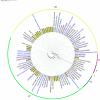Genetic diversity and virulence of Bacillus cereus group isolates from bloodstream infections
- PMID: 39873504
- PMCID: PMC11878096
- DOI: 10.1128/spectrum.02407-24
Genetic diversity and virulence of Bacillus cereus group isolates from bloodstream infections
Abstract
Bacillus cereus catheter-related bloodstream infections (CRBSIs) are an increasing concern in Japanese hospitals. Although their clinical characteristics have been explored, the genetic relationships and virulence profiles of B. cereus isolates from CRBSIs remain understudied. Here, using advanced genomic techniques, we investigated the genetic diversity, phylogenetic relationships, and virulence profiles of B. cereus isolates from patients with bloodstream infections. We analyzed 28 B. cereus group strains isolated from blood samples at the University of Tokyo Hospital between 2005 and 2017 using whole-genome sequencing, core-genome single-nucleotide polymorphism (SNP) typing, and virulence gene profiling. Core-genome SNP analysis revealed significant genetic diversity among the isolates, suggesting multiple independent sources of infection. The isolates predominantly belonged to panC clades III and IV, with distinct virulence gene profiles. All panC clade III isolates contained hbl operon genes, whereas four isolates from clade IV harbored cereulide synthetase genes (cesABCD). One isolate possessed a capsule gene operon (capBCADE), a rare finding among clinical B. cereus strains. Biofilm formation ability was observed in 50% of catheter-related isolates, although this ability was not significantly different from that of the noncatheter-related isolates.IMPORTANCEThis study provides novel insights into the genetic diversity and virulence potential of B. cereus strains causing bloodstream infections in a Japanese hospital setting. These findings suggest diverse infection pathways and highlight the importance of continuous molecular epidemiological surveillance for effective infection control.
Keywords: Bacillus cereus group; bloodstream infection; epidemiology; whole-genome analysis.
Conflict of interest statement
The authors declare no conflict of interest.
Figures




Similar articles
-
Comprehensive genomic analysis reveals virulence and antibiotic resistance genes in a multidrug-resistant Bacillus cereus isolated from hospital wastewater in Bangladesh.Sci Rep. 2025 Jul 2;15(1):22915. doi: 10.1038/s41598-025-06655-w. Sci Rep. 2025. PMID: 40594904 Free PMC article.
-
Genomic surveillance for multidrug-resistant or hypervirulent Klebsiella pneumoniae among United States bloodstream isolates.BMC Infect Dis. 2022 Jul 7;22(1):603. doi: 10.1186/s12879-022-07558-1. BMC Infect Dis. 2022. PMID: 35799130 Free PMC article.
-
Whole-genome sequence-based comparison and profiling of virulence-associated genes of Bacillus cereus group isolates from diverse sources in Japan.BMC Microbiol. 2019 Dec 16;19(1):296. doi: 10.1186/s12866-019-1678-1. BMC Microbiol. 2019. PMID: 31842760 Free PMC article.
-
Catheter impregnation, coating or bonding for reducing central venous catheter-related infections in adults.Cochrane Database Syst Rev. 2016 Mar 16;3(3):CD007878. doi: 10.1002/14651858.CD007878.pub3. Cochrane Database Syst Rev. 2016. PMID: 26982376 Free PMC article.
-
The risk of catheter-related bloodstream infection with femoral venous catheters as compared to subclavian and internal jugular venous catheters: a systematic review of the literature and meta-analysis.Crit Care Med. 2012 Aug;40(8):2479-85. doi: 10.1097/CCM.0b013e318255d9bc. Crit Care Med. 2012. PMID: 22809915
References
-
- Okamoto A, Okutani A. 2024. The Bacillus cereus group, p 957–986. In Yi-Wei Tang MH, Dongyou L, Sails A, Spearman P, Zhang JR (ed), Molecular medical microbiology. Elsevier, London.
-
- Glasset B, Herbin S, Granier SA, Cavalié L, Lafeuille E, Guérin C, Ruimy R, Casagrande-Magne F, Levast M, Chautemps N, Decousser J-W, Belotti L, Pelloux I, Robert J, Brisabois A, Ramarao N. 2018. Bacillus cereus, a serious cause of nosocomial infections: epidemiologic and genetic survey. PLoS One 13:e0194346. doi:10.1371/journal.pone.0194346 - DOI - PMC - PubMed
-
- Mills E, Sullivan E, Kovac J. 2022. Comparative analysis of Bacillus cereus group isolates’ resistance using disk diffusion and broth microdilution and the correlation between antimicrobial resistance phenotypes and genotypes. Appl Environ Microbiol 88:e0230221. doi:10.1128/aem.02302-21 - DOI - PMC - PubMed
-
- Aoyagi T, Oshima K, Endo S, Baba H, Kanamori H, Yoshida M, Tokuda K, Kaku M. 2020. Ba813 harboring Bacillus cereus, genetically closely related to Bacillus anthracis, causing nosocomial bloodstream infection: bacterial virulence factors and clinical outcome. PLoS One 15:e0235771. doi:10.1371/journal.pone.0235771 - DOI - PMC - PubMed
MeSH terms
LinkOut - more resources
Full Text Sources
Molecular Biology Databases
Research Materials

